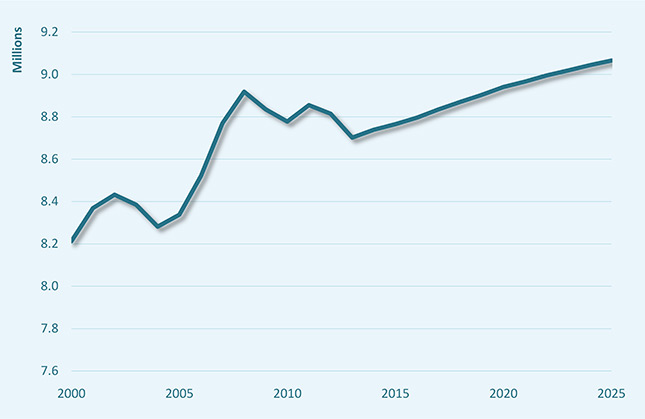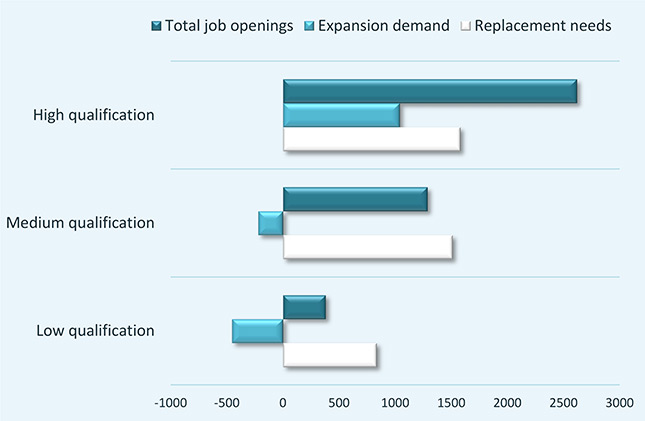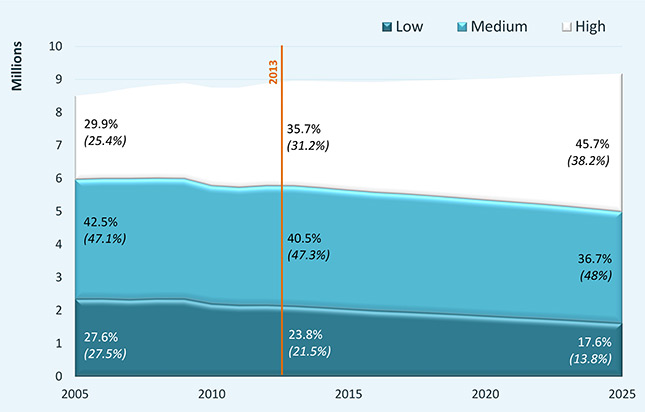
Netherlands: Forecast highlights up to 2025
Between now and 2025:
- Employment is forecast to rise, passing its pre-crisis 2008 level by 2019-20 and continue to increase.
- Most employment growth will be in distribution and transport, and business and other services.
- Most job opportunities, around 34%, will be for professionals.
- By 2025, around 30.8% of the labour force will have high-level qualifications, compared to 20.7% in 2013.
- Around 46% of the labour force will have high-level qualifications, compared to 36% in 2013.
Following the economic crisis in 2008, the Netherlands’ GDP started to recover in 2011. In 2013, the Netherlands’ unemployment rate was 6.7%, well below the European Union (EU) average of 11%. The European Commission Economic forecasts GDP growth for the Netherlands of 1.4 % in 2015 and 1.6 % in 2016.
Employment outlook
According to Cedefop’s skills supply and demand forecasts (see scenario assumptions) economic growth is expected to have a positive effect on employment in the Netherlands, which is expected to reach its 2008 pre-crisis level in 2019-20 (Figure 1). This is in line with employment growth forecast for the EU as a whole, where average employment is expected to reach its pre-crisis level in 2020.

Sector developments
The economic crisis reduced employment, mainly in the primary, manufacturing and construction sectors between 2008 and 2013 (Figure 2). However, employment in non-marketed (mainly public sector) services increased over the same period. Future employment growth in the Netherlands up to 2025 will in business and other services, and the distribution and transport sector. Job growth is also forecast for the primary and construction sectors, but employment in manufacturing is forecast to fall.
 Source: Cedefop skills forecasts (2015)
Source: Cedefop skills forecasts (2015)Occupations and qualifications prospects
Cedefop’s forecasts give insights on job opportunities between now and 2025. Total job opportunities are the sum of newly created jobs (expansion demand) and job opportunities arising because of the need to replace people who either go on to other jobs or leave the labour market, for example due to retirement (replacement demand). Often, replacement demand provides more job opportunities than expansion demand, which means that there will still be job opportunities even if the overall level of employment falls. As the working population ages, between now and 2025, replacement demand in Netherlands is forecast to provide more than ten times more job opportunities than expansion demand.
More than one third of all jobs opportunities in the Netherlands between now and 2025 will be for professionals (high level occupations in science, engineering healthcare, business and teaching) followed by service and sales workers around 17%, significantly higher than the EU averages of 24% and 16% respectively for these occupations (Figure 3). Shares of job opportunities for plant and machine operators and skilled agriculture workers, both 2% in the Netherlands, are well below the EU averages of 4% and 6% respectively, for these occupational groups.
 Source: Cedefop skills forecasts (2015)
Source: Cedefop skills forecasts (2015)All job opportunities created through expansion demand and most job opportunities overall in the Netherlands will require high-level qualifications (ISCED 97 levels 5 and 6). However, because of high replacement demand, there will be significant proportions of job opportunities requiring medium-level qualifications (ISCED 97 levels 3 and 4).
 Source: Cedefop skills forecasts (2015)
Source: Cedefop skills forecasts (2015)Labour force trends
Future labour supply trends depend mainly on demographics and the size of the working-age population (defined in the forecasts as people over 15 years old), participation in the labour force (people in the working-age population either in or actively seeking work) and how quickly people acquire formal qualifications.
Eurostat’s latest population projection (Europop 2013) for the Netherlands reflects the current trends in fertility rates and net migration flows. The Netherlands working-age population is projected to grow by more than 5% between now and 2025. However, labour market participation is expected to fall from 64% to 62% in 2025, still above the EU forecast average of 55.5%.
Following the EU demographic trend, the Netherlands’ population is getting older (Figure 5). Between now and 2025, there will be a small increase in numbers of people in the labour force between 25 and 39 years-old, but a larger increase of people aged over 55.
 Source: Cedefop skills forecasts (2015)
Source: Cedefop skills forecasts (2015)Although older, the Netherland’s labour force is becoming more highly qualified (Figure 6). This is explained by older less-qualified people leaving and younger more highly-educated people entering the labour market. By 2025, the share of the Netherland’s labour force with high-level qualifications should rise to 45.7% compared to 35.7 % in 2013 and 29.9% in 2005. People with medium-level qualifications in 2025 will account for 36.7 % of the labour force, compared to 40.5% in 2013. The share of the labour force with low-level or no qualifications is forecast to fall from 23.8% in 2013 to 17.6 % in 2025.
According to Cedefop’s forecasts, by 2020, in the Netherlands around 56.5% of 30 to 34 year-olds will have high level qualifications, significantly above the EU’s educational attainment benchmark of 40% by 2020. On current trends, around 64.2% of 30 to 34 year-olds will have high-level qualifications by 2025.
 Source: Cedefop skills forecasts (2015)
Source: Cedefop skills forecasts (2015)In 2013, in the Netherlands, 9.2 % of young people left the education and training system with low-level qualifications, above the national target of reducing this to below 8% by 2020. In the EU, the average, in 2013, was 11.9%, still higher than its benchmark of less than 10 % of young people leaving the education and training system with low-level qualifications by 2020.
Experts’ view
Cedefop’s forecasts and their assumptions are regularly discussed with national experts. Mr. Ben Kriechel Managing partner at the Economix Research and Consultancy considers the forecasts’ underlying assumptions and its results plausible.
However, he adds that the European population projection slightly underestimates the national population projection. The underlying forecast of macroeconomic trends is considered to be broadly in line with the national forecasts of Netherlands.
Cedefop skills supply and demand forecasts’ scenario
Cedefop skills supply and demand forecasts take account of global economic developments up to October 2014. Despite significant differences between countries, the forecasts generally assume that a modest economic recovery will slowly increase confidence in the EU, increasing investment, consumer spending and exports. Inflation stays in target range and interest rates low, while higher tax revenues help governments reduce debt.
The assumptions reflect the latest Eurostat population forecast (Europop 2013, published in spring 2014) and the short-term macroeconomic forecast produced by the European Commission in November 2014.
Cedefop’s forecasts use harmonised data and methodology for all countries covered to allow cross-country comparisons. They do not substitute national forecasts. Total employment data correspond to those reported in national accounts.
Cedefop’s latest skills demand and supply forecasts up to 2025 cover 28 EU Member States plus Iceland, Norway and Switzerland. Results are regularly updated and together with key assumptions and methodological developments are reviewed by national experts.
For the latest update and more detailed skills forecast data visit: www.cedefop.europa.eu/forecast



